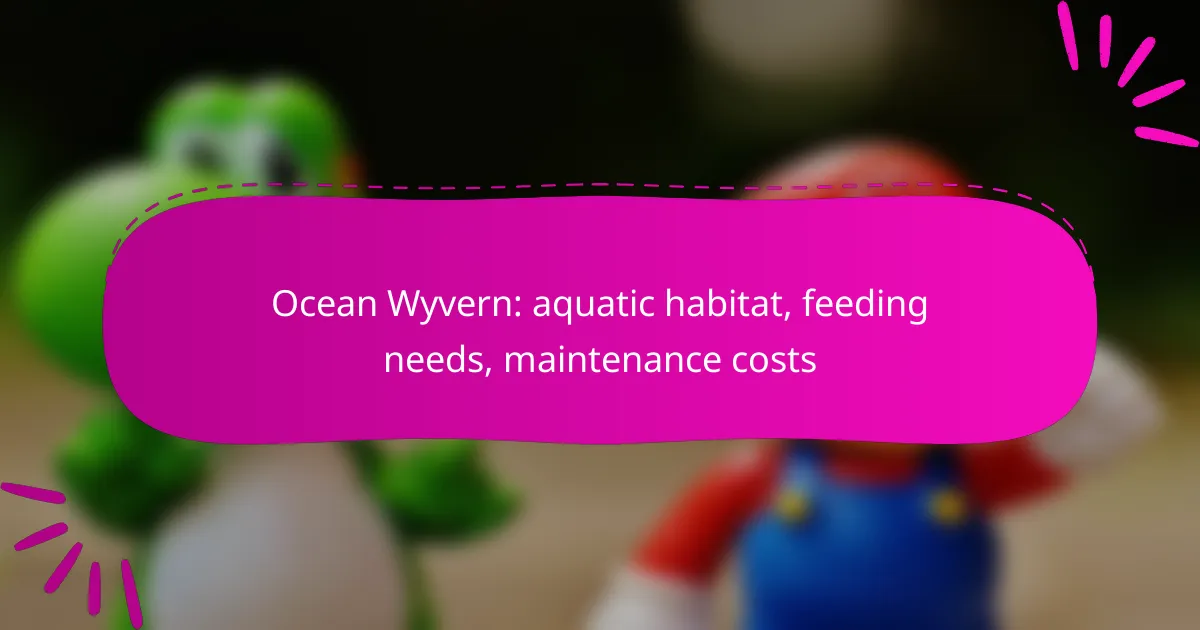Ice Wyverns are unique creatures that require specific habitat conditions to thrive, including cold temperatures, access to freshwater, and elevated nesting areas. To support their needs, effective cooling systems must be implemented, utilizing refrigerated enclosures and humidity control to replicate their natural environment. Additionally, the feeding costs for Ice Wyverns can vary, necessitating a moderate investment in specialized feed to ensure their health and vitality.

What are the habitat requirements for Ice Wyverns?
Ice Wyverns thrive in specific environments that mimic their natural habitats. They require cold temperatures, access to freshwater, and elevated nesting areas to ensure their survival and reproduction.
Cold mountainous regions
Ice Wyverns are primarily found in cold mountainous regions where temperatures remain low throughout the year. These areas provide the frigid climate necessary for their physiological needs and help them maintain their icy appearance.
When selecting a location, look for elevations above 1,500 meters, where snow and ice are prevalent. Avoid areas that experience significant warming, as this can lead to habitat loss and increased stress on the wyverns.
Access to freshwater sources
Freshwater sources are crucial for Ice Wyverns, as they need to hydrate and cool themselves. Rivers, lakes, and streams that remain unfrozen during the colder months are ideal for these creatures.
Ensure that the freshwater sources are clean and free from pollutants, as contaminated water can negatively impact their health. Additionally, proximity to these water sources can aid in hunting and feeding, making it easier for them to catch prey.
High-altitude nesting areas
High-altitude nesting areas are essential for Ice Wyverns to protect their young from predators and harsh weather conditions. These nests are typically built on cliffs or in caves that offer shelter and a strategic vantage point.
When choosing a nesting site, look for locations that are difficult for ground predators to access. The nests should be well-insulated to keep the eggs warm while still allowing for ventilation to prevent overheating.

How to create effective cooling systems for Ice Wyverns?
To create effective cooling systems for Ice Wyverns, focus on maintaining low temperatures and high humidity levels that mimic their natural habitat. Implementing a combination of refrigerated enclosures, evaporative cooling methods, and temperature regulation technologies will ensure optimal conditions for these creatures.
Refrigerated enclosures
Refrigerated enclosures are essential for providing a stable, cold environment for Ice Wyverns. These enclosures should maintain temperatures consistently below 10°C (50°F) to mimic their natural habitat. Ensure that the insulation is adequate to prevent heat transfer from the outside.
Consider using industrial-grade refrigeration units capable of handling the specific volume of the enclosure. Regular maintenance is crucial to avoid breakdowns, which could lead to dangerous temperature fluctuations.
Evaporative cooling methods
Evaporative cooling methods can supplement refrigerated enclosures by increasing humidity and lowering temperatures. Utilizing water features, such as misting systems or small ponds, can enhance the cooling effect while providing hydration for the Ice Wyverns.
When implementing these methods, ensure that the water quality is monitored to prevent algae growth and other contaminants. A well-designed evaporative system can lower temperatures by several degrees, making it a valuable addition to the cooling strategy.
Temperature regulation technologies
Temperature regulation technologies, such as smart thermostats and automated climate control systems, are vital for maintaining optimal conditions for Ice Wyverns. These systems can monitor temperature and humidity levels in real-time, adjusting cooling mechanisms as needed.
Investing in reliable sensors and control systems can help prevent temperature spikes or drops, which could stress the Ice Wyverns. Regularly calibrate these devices to ensure accuracy and responsiveness, enhancing the overall effectiveness of the cooling systems.

What are the feeding costs for Ice Wyverns?
The feeding costs for Ice Wyverns can vary significantly based on their dietary needs and the availability of specialized feed. On average, owners should expect to spend a moderate amount on feed, which is essential for maintaining the health and energy levels of these creatures.
Cost of specialized feed
Ice Wyverns require a specific type of feed that often includes high-protein options such as fish or specially formulated pellets. The cost of this specialized feed can range from $50 to $150 per month, depending on the source and quality. It’s advisable to compare suppliers to find the best prices while ensuring the feed meets nutritional standards.
Feeding frequency and quantity
Typically, Ice Wyverns should be fed once every two to three days, consuming about 5 to 10% of their body weight each time. This feeding frequency helps maintain their energy levels without overfeeding, which can lead to health issues. Monitoring their weight and adjusting the quantity accordingly is crucial for optimal health.
Seasonal price variations
Feeding costs for Ice Wyverns may fluctuate with seasonal changes, particularly if certain food sources become scarce or more expensive. During colder months, prices for high-quality feed may rise due to increased demand. It’s wise to stock up on feed during off-peak seasons to mitigate these costs and ensure a steady supply.

What are the best food sources for Ice Wyverns?
Ice Wyverns thrive on a diet rich in specific food sources that provide essential nutrients for their growth and energy. The best options include frozen fish and meat, high-protein supplements, and local forage options that are readily available in their habitat.
Frozen fish and meat
Frozen fish and meat serve as primary food sources for Ice Wyverns due to their high protein content and palatability. Options like salmon, mackerel, and other fatty fish are particularly beneficial, providing the necessary energy for these creatures. It’s advisable to ensure that the fish and meat are sourced from clean waters to avoid contaminants.
When feeding, consider offering portions that are roughly 5-10% of the wyvern’s body weight to maintain optimal health. Regularly rotating the types of fish and meat can prevent dietary deficiencies.
High-protein supplements
High-protein supplements can enhance the diet of Ice Wyverns, especially during breeding or growth phases. Products such as fish meal or specialized wyvern feed are excellent choices, as they are formulated to meet the nutritional needs of these creatures. Look for supplements that contain at least 30-40% protein to ensure adequate intake.
Mixing these supplements with their regular diet can improve overall health and vitality. However, avoid over-supplementation, as it can lead to digestive issues.
Local forage options
Local forage options can complement the diet of Ice Wyverns, particularly in areas where fish and meat may be scarce. Edible plants, berries, and small mammals can provide additional nutrients. For instance, wild berries are a good source of vitamins and can be easily foraged in colder climates.
Incorporating local forage into their diet can help diversify their nutrient intake. However, ensure that any foraged items are safe and non-toxic, as some plants can be harmful to wyverns. Regularly assess the availability of these options to adapt their diet accordingly.

How do Ice Wyverns adapt to climate changes?
Ice Wyverns adapt to climate changes through a combination of behavioral, physiological, and migratory strategies. These adaptations allow them to thrive in fluctuating temperatures and maintain their survival in diverse environments.
Behavioral adaptations
Ice Wyverns exhibit several behavioral adaptations to cope with climate variations. They often seek out shaded or cooler areas during heat waves, which helps them regulate their body temperature. Additionally, they may alter their hunting and feeding times to avoid the hottest parts of the day, becoming more active during cooler mornings and evenings.
Social behaviors also play a role; Ice Wyverns may congregate in groups to share warmth during colder periods, enhancing their survival chances. This social structure can also provide protection against predators.
Physiological changes
Physiologically, Ice Wyverns have developed unique adaptations that allow them to withstand extreme temperatures. Their bodies can produce antifreeze proteins that prevent ice crystal formation in their tissues, which is crucial during freezing conditions. This adaptation helps maintain cellular integrity and function.
Moreover, their metabolic rates can adjust based on environmental temperatures. In colder climates, Ice Wyverns may slow their metabolism to conserve energy, while in warmer conditions, they can ramp it up to maintain activity levels.
Migration patterns
Migration is a key strategy for Ice Wyverns in response to climate changes. They typically migrate to higher altitudes or latitudes during warmer months to find cooler habitats. This seasonal movement allows them to access more favorable conditions for breeding and feeding.
During migrations, Ice Wyverns often follow established routes that provide access to essential resources like food and shelter. Understanding these patterns can be crucial for conservation efforts, as disruptions to their migratory paths can significantly impact their populations.










